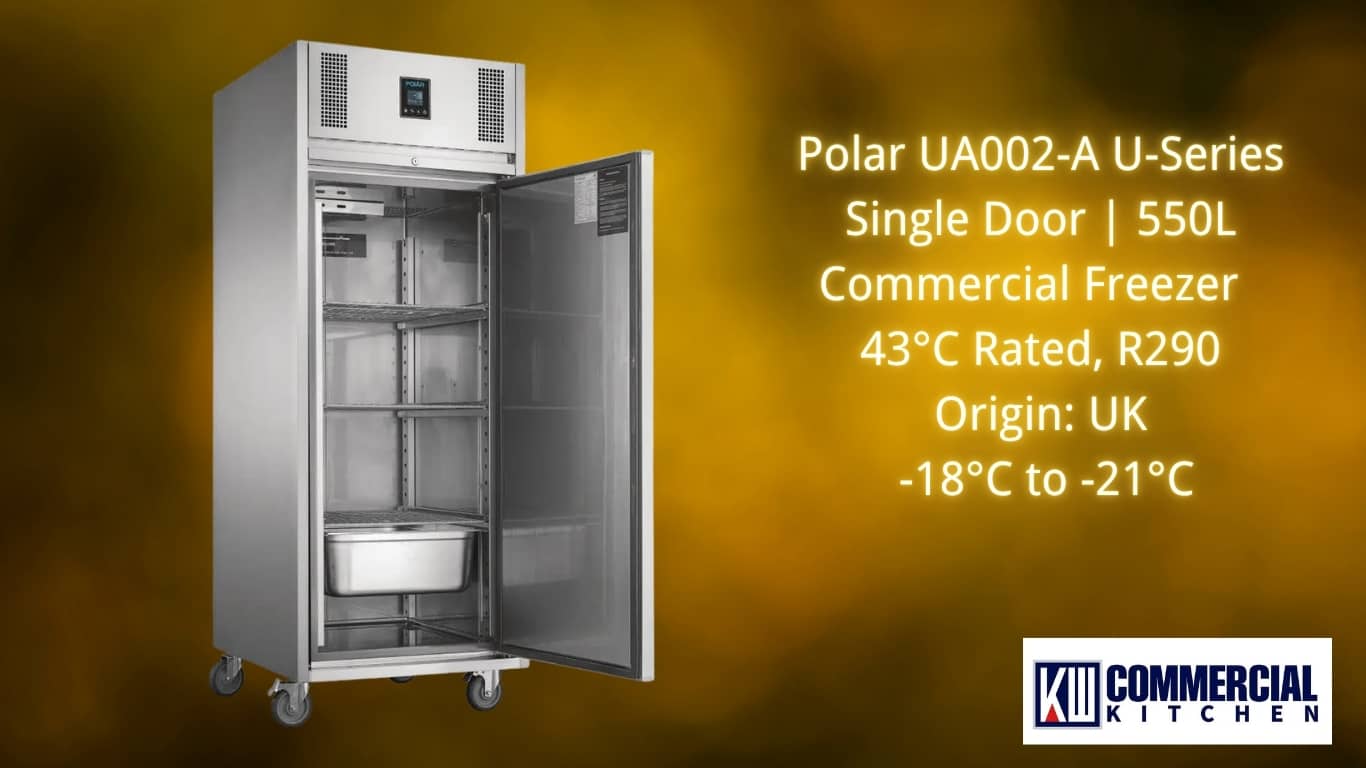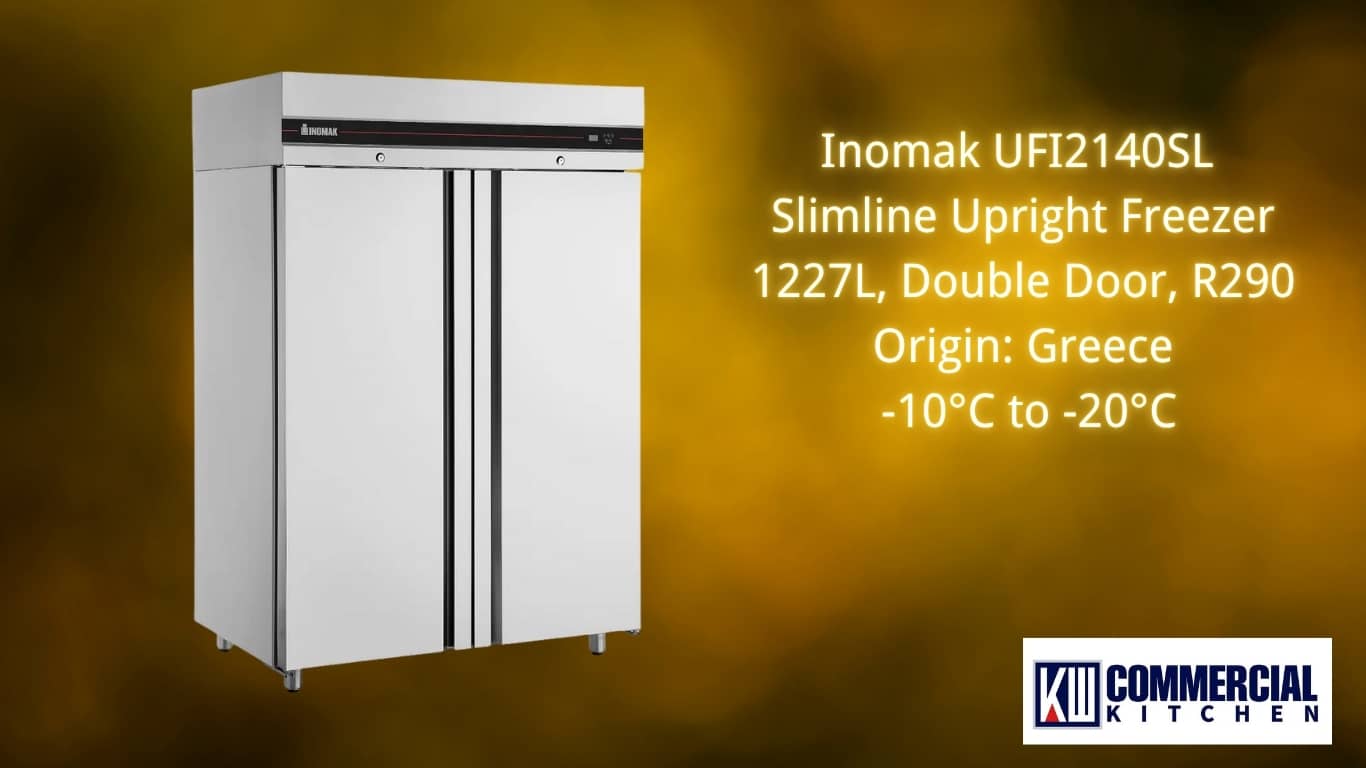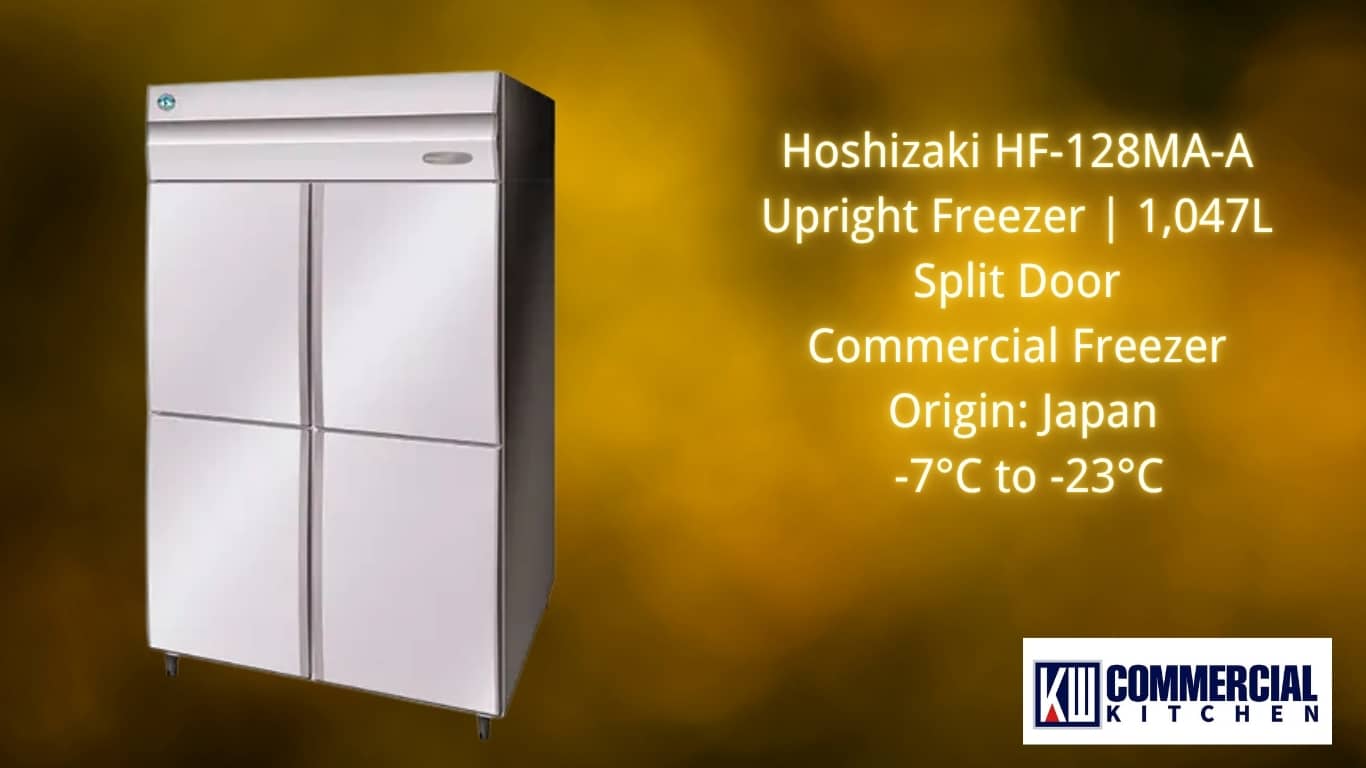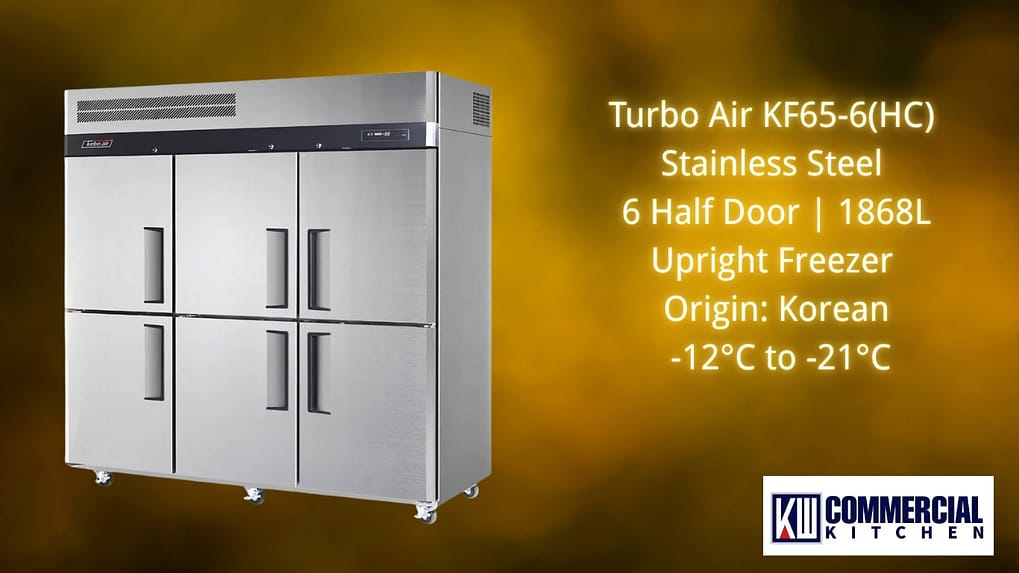7 Critical Things Aussie Businesses Must Know Before Buying an Upright Freezer (2025 Guide)
If you’re running a café in Sydney, a bustling restaurant in Melbourne, or managing a growing catering business in Brisbane, the choice of freezer isn’t just another appliance decision—it’s an investment in efficiency, food safety, and cost management. Upright freezers have surged in popularity across Australia, thanks to their space-saving design, convenience, and significant energy-efficiency advantages over traditional chest freezers.
But with numerous models, confusing specifications, and varying energy ratings, choosing the right upright freezer can quickly become overwhelming. Australian businesses face unique challenges, from rising electricity prices to strict local food safety regulations. According to recent data from the Australian Energy Rating Authority, outdated freezers consume up to 30% more electricity, significantly impacting profitability for commercial kitchens.
In this straightforward, expert-backed guide, you’ll get real answers and actionable advice to make an informed decision. You’ll learn exactly what to look for—and what costly mistakes to avoid—when purchasing an upright freezer for your Australian business. We’ve included detailed product comparisons, genuine reviews from local business owners, maintenance tips tailored to Aussie climates, and insights into government rebates that can substantially reduce your upfront investment.
Here’s what you’ll discover in this guide:
- Key differences between upright and chest freezers (and which makes more sense for your Aussie kitchen).
- Frost-free vs manual defrost—what saves Australian businesses more money long-term?
- Why stainless steel upright freezers are the top choice for food safety compliance in Sydney and Melbourne.
- Common upright freezer buying mistakes and how to easily avoid them.
- Detailed reviews of Australia’s top commercial upright freezer models (capacity, energy ratings, prices).
- Practical guidance on Australian government rebates and incentives available in 2025.
By the end of this article, you’ll be equipped with all the essential knowledge to confidently select an upright freezer that meets your business’s needs and ensures your kitchen operates at peak efficiency.
Let’s get started and set your Aussie business up for lasting success.
Upright Freezer vs Chest Freezer: Which is Better for Australian Businesses?
Choosing between an upright freezer and a chest freezer is often the first critical decision for Australian restaurant and café owners. Both have distinct advantages, but the best choice depends heavily on your specific business requirements, available space, and daily operations.
Key Differences: Capacity, Space Efficiency & Energy Usage
Here’s a quick comparison highlighting practical differences relevant for Australian kitchens:
| Feature | Upright Freezer | Chest Freezer |
|---|---|---|
| Space Efficiency | Vertical storage, ideal for smaller kitchens (Sydney CBD cafés) | Requires larger floor space; suitable for spacious areas |
| Capacity & Organization | Easy organization with shelves; quickly locate items | Large volume storage; challenging to organize effectively |
| Energy Consumption | Slightly higher energy usage; better with newer energy-efficient models | Generally lower energy consumption due to design, but less convenient |
Pros and Cons for Australian Commercial Kitchens
To illustrate further, let’s consider real Australian business scenarios:
- Upright Freezers – Pros: Excellent for space-constrained restaurants in Melbourne or Sydney. Easy to organize and maintain, making daily operations smoother. Front-opening doors minimize the hassle of accessing items quickly.
- Upright Freezers – Cons: Often cost more upfront and may consume slightly more power if not chosen carefully.
- Chest Freezers – Pros: Economical upfront price and lower energy costs, ideal for bulk storage in larger establishments with ample space, such as catering services in Brisbane or Perth.
- Chest Freezers – Cons: Difficult to organize effectively, increased staff time spent searching for items, less practical for busy commercial kitchens.
Expert Recommendation: Which Type Fits Your Australian Business?
We recently spoke with Andrew Collins, head chef at a busy café in Melbourne’s CBD, who switched from a chest freezer to an upright freezer:
“Switching to an upright freezer significantly improved our workflow. We saved around 30 minutes a day simply by better organization and quicker access, easily offsetting slightly higher energy costs. For tight kitchen spaces and fast-paced operations, upright freezers are unbeatable.”
Conversely, for a catering company in Perth, a chest freezer provided better value due to ample storage space and lower operational demands.
To summarize:
- Choose an upright freezer if you’re operating in a busy, space-constrained environment, particularly in cities like Sydney or Melbourne, where quick access and space optimization matter most.
- Choose a chest freezer if your business involves bulk storage and space isn’t a limitation, suitable for larger catering services or businesses with dedicated storage areas.
By carefully considering your specific operational needs, available space, and budget, you’ll make the right choice that directly enhances efficiency and profitability.

Frost-Free or Manual Defrost—Which Type Saves Aussie Businesses More?
One critical decision when selecting an upright freezer for your Australian business is choosing between a frost-free or a manual defrost model. Each has distinct advantages and disadvantages, directly influencing your running costs, maintenance efforts, and overall convenience.
Pros & Cons of Frost-Free Upright Freezers in Australian Conditions
Firstly, let’s clarify: are upright freezers frost free? Not all—but many modern commercial upright freezers offer frost-free technology. Here’s a clear breakdown of the pros and cons for Aussie businesses:
- Pros of Frost-Free Freezers:
- Convenience & Labour Savings: Frost-free models eliminate the hassle of manual defrosting, saving businesses significant labour time.
- Improved Efficiency: No frost buildup means better airflow and more consistent temperatures, essential for maintaining food quality and complying with Australian food safety standards.
- Cleaner Storage: Reduces moisture buildup, maintaining a cleaner and safer environment for food storage.
- Cons of Frost-Free Freezers:
- Higher Initial Cost: Typically, frost-free models cost more upfront compared to manual defrost options.
- Slightly Increased Energy Consumption: The auto-defrost cycle can marginally increase electricity usage, particularly noticeable in regions with higher electricity costs like South Australia.
Maintenance & Hidden Costs—Real Aussie Experiences
Many businesses initially overlook the ongoing costs of maintaining their upright freezer. Here’s what two Australian business owners shared about their experiences:
Maria L. from Café Espresso, Adelaide: “We initially saved money with a manual defrost freezer, but soon realised our mistake. Every few months, we’d spend hours defrosting, and our staff often damaged products in the process. Switching to frost-free was a game-changer.”
Mark T. from Melbourne’s Dockside Bistro: “Our frost-free freezer ran beautifully for two years but then unexpectedly required servicing due to an internal coil issue. The repair cost about AUD $350. While not a massive expense, it was unexpected and is worth considering.”
Clearly, frost-free freezers offer convenience, but you must factor in potential servicing and slightly increased electricity bills into your budgeting decisions.
Recommendation: Ideal Freezer for Commercial Use in Sydney & Melbourne
For busy restaurants and cafés, particularly those operating in fast-paced environments like Sydney CBD or inner-city Melbourne, frost-free upright freezers generally provide better long-term value. The convenience and time savings significantly outweigh minor energy increases or occasional maintenance needs.
Here are quick maintenance tips to maximise your frost-free freezer’s efficiency and lifespan in Australian conditions:
- Regular Cleaning: Clean internal shelves and walls quarterly to prevent odours and ensure proper airflow.
- Ventilation Check: Ensure your freezer has sufficient ventilation space at the back and sides, crucial during hot Aussie summers.
- Professional Servicing: Have your freezer serviced every 1-2 years to avoid unexpected breakdowns, especially in high-usage environments.
Ultimately, the minimal additional upfront investment in a frost-free upright freezer is justified by significant savings in labour, reduced food spoilage, and smoother daily operations.
Stainless Steel Commercial Freezers—Luxury or Necessity?
Many Australian restaurant owners initially perceive stainless steel commercial freezers as merely a stylish luxury. Yet, for busy cafés in Sydney, high-end restaurants in Melbourne, or catering businesses across Australia, stainless steel offers essential advantages in terms of hygiene, durability, and compliance with strict food safety regulations.
Hygiene & Durability—Australia’s Strict Food Safety Standards Explained
Australian food safety laws are stringent—and for good reason. Businesses must ensure food is stored safely, hygienically, and at stable temperatures. Stainless steel freezers naturally support these requirements due to their inherent properties:
- Easy Cleaning & Sanitation: Stainless steel surfaces are smooth and non-porous, making them easier to clean and disinfect, significantly reducing the risk of contamination.
- Corrosion & Rust Resistance: Given Australia’s coastal locations—especially in Sydney, Brisbane, or Perth—stainless steel withstands humidity and salty air far better than coated steel alternatives.
- Long-term Durability: Stainless steel freezers are remarkably resistant to dents, scratches, and damage from frequent daily use, making them ideal for Australia’s busiest commercial kitchens.
Meeting these high standards directly contributes to higher inspection ratings and customer confidence, both critical to the longevity and success of Australian food establishments.
Cost-Benefit Analysis for Stainless Steel Freezers (Australian Market Data)
To determine whether stainless steel commercial freezers are worth their cost, consider this practical cost-benefit breakdown based on recent Australian market data:
| Factor | Stainless Steel Freezer | Regular Coated Steel Freezer |
|---|---|---|
| Initial Cost (AUD) | $2,500 – $9,000 | $1,500 – $3,000 |
| Lifespan (years) | 10-15 years (High Durability) | 6-10 years (Moderate Durability) |
| Maintenance Costs | Lower (Easy to clean, minimal corrosion) | Higher (Prone to rust, frequent repairs) |
| Food Safety Compliance | Excellent (Easy compliance) | Moderate (Risk of hygiene issues) |
While the upfront cost of stainless steel freezers is higher, their longer lifespan, lower maintenance expenses, and reliable hygiene compliance translate into significant long-term savings and benefits—making them arguably the best commercial freezer Australia has to offer.
Real Aussie Restaurants Share Their Experiences
Nothing speaks louder than genuine experiences from Australian restaurant operators:
Jessica M., Owner of Bondi Beach Café, Sydney:
“We invested in stainless steel freezers two years ago. The ease of cleaning and reduced maintenance has saved countless hours. Our kitchen has also passed every health inspection with ease, giving us peace of mind.”
Daniel R., Executive Chef at The Gourmet Grill, Melbourne:
“Our stainless steel commercial freezer is still in perfect shape after five intensive years. No rust, minimal scratches, and easy to sanitize—it’s honestly one of our smartest investments.”
These real-world testimonials underline that stainless steel commercial freezer benefits aren’t simply about aesthetics; they’re crucial for daily operations, food safety compliance, and overall profitability in the Australian hospitality industry.
Ultimately, for serious businesses seeking long-term reliability, cleanliness, and compliance, stainless steel commercial freezers are not just a luxury—they’re a necessity.

Common Mistakes Australians Make When Choosing an Upright Freezer
Choosing an upright freezer seems straightforward, yet many Australian businesses unknowingly make costly mistakes. To ensure you avoid common pitfalls, we’ve highlighted the key issues often overlooked during selection.
Ignoring Energy Efficiency Ratings – Understand Australian Energy Labels
Many Australian businesses underestimate the importance of energy efficiency ratings when selecting a freezer. Australia’s official Energy Rating System provides clear, government-regulated guidelines to help businesses compare appliance efficiency easily.
The more stars an appliance has, the less electricity it consumes—potentially saving your business hundreds of dollars annually. For example, a 3-star rated freezer could cost approximately 30% more annually in electricity than a comparable 5-star rated model.
Ignoring these ratings means higher operating costs, decreased profitability, and unnecessary environmental impact. Always check and prioritize higher-star rated freezers for long-term savings.
Choosing the Wrong Size or Capacity – A Typical Aussie Restaurant Mistake
Another common mistake Australian businesses make is selecting a freezer size without adequately assessing their true storage requirements. Choosing too small a freezer forces staff into constant reorganizing, increasing labour costs, while an overly large freezer wastes energy and space.
Consider this scenario from a busy café in Sydney:
“Initially, we bought a smaller freezer thinking we’d save money, but it turned out to be inefficient. Our staff constantly struggled with overcrowded shelves and frequent defrosting issues. Upgrading to a slightly larger model significantly improved operations.” – Alex, Owner of City Brew Café, Sydney CBD.
When choosing freezer size for commercial kitchens in Sydney, always account for your peak storage needs and potential future growth, ensuring optimal operational efficiency.
Underestimating Maintenance and Transport Issues – Advice from CHOICE.com.au
Maintenance and transportation are often overlooked when buying an upright freezer. According to Australia’s consumer advocacy group CHOICE.com.au, neglecting these practical concerns can lead to significant operational disruptions.
One frequently asked question CHOICE addresses is: “Can I lay an upright freezer down for transport?” Their advice is clear—while possible, it is not recommended. If laid horizontally, compressors and internal fluids may shift, risking permanent damage. If unavoidable, CHOICE recommends:
- Lay the freezer on the compressor side, carefully padded.
- Upon arrival, let it stand upright unplugged for at least 24 hours before use.
Similarly, routine maintenance, such as regular defrosting and condenser coil cleaning, is crucial. Overlooking these tasks can drastically reduce freezer lifespan and performance, ultimately costing your business far more than simple preventive measures.
By proactively addressing these overlooked considerations—energy ratings, correct sizing, and proper maintenance and transport procedures—you’ll avoid expensive mistakes and ensure your investment remains profitable for years.
The Best Commercial Upright Freezers in Australia—Real Reviews & Comparisons
Selecting the right commercial upright freezer for your Australian business can significantly impact your daily operations, energy bills, and food quality. To simplify your choice, we’ve carefully selected and reviewed some of the most trusted and highly rated commercial upright freezers in Australia.
| Brand/Model | Capacity | Energy Efficiency | Price (AUD) | Best For |
|---|---|---|---|---|
| Bromic Upright Freezer (5yr warranty) | 1300L | ★★★★☆ | $4,766.50+ | Busy Cafés |
| Turbo Air Commercial Stainless Steel (3yr warranty) | 1898L | ★★★★★ | $7,075.60+ | High-Volume Restaurants |
| Polar Stainless Steel Freezer (2yr warranty) | 550L | ★★★★★ | $4,699+ | Mid-sized Kitchens |
| Hoshizaki Upright Freezer (2yr warranty) | 1047L | ★★★★☆ | $4,865+ | Premium Restaurants |
| Inomak Commercial Freezer (2yr warranty, Greece) | 1227L | ★★★★☆ | $5,600+ | Gourmet Establishments |
| Thermaster (2yr warranty) | 340L | ★★★☆☆ | $1,349+ | Small Cafés & Kiosks |
| Atosa (2+2yr warranty) | 410L | ★★★★☆ | $2,579+ | Medium-Sized Cafés |
Expert Picks & Real Australian User Reviews
Our top expert pick for Melbourne-based restaurants is the Turbo Air Commercial Stainless Steel Freezer. With its superior energy rating, self-cleaning condenser, and substantial storage capacity, it provides exceptional efficiency and reliability for busy kitchens.
Real User Reviews:
Tom J., Melbourne Bistro Owner: “The Turbo Air freezer transformed our kitchen—energy bills noticeably dropped, and we have had zero maintenance issues in over two years. It’s hands-down the best investment we’ve made.”
Emily S., Café Owner, Sydney: “Our Bromic freezer fits perfectly in our limited kitchen space and provides plenty of storage. The 5-year warranty gave us peace of mind, and it’s worked flawlessly since day one.”
To make the right choice, carefully evaluate your business size, budget, and operational needs. Each recommended freezer above represents the best upright freezer reviews in Australia, ensuring you choose a dependable, cost-effective solution for your commercial kitchen.
Maximizing Your Investment—Australian Government Rebates & Incentives
Choosing an energy-efficient commercial freezer is smart for your business—and the environment—but did you know Australian businesses can also access substantial government incentives? Leveraging these rebates and incentives significantly reduces your upfront investment, enhancing long-term profitability.
Small Business Energy Efficiency Rebates—How to Save Thousands
The Australian government actively encourages small businesses to adopt energy-efficient appliances, including commercial freezers. Under programs like the Energy Efficient Communities Program, eligible small businesses can claim significant rebates covering the cost of purchasing energy-saving commercial equipment.
Here’s how it works practically:
- Check your eligibility via the official Australian Government Grants and Programs Portal.
- Purchase an approved energy-efficient commercial freezer listed on the official Energy Rating website.
- Submit your receipt and rebate application online, receiving reimbursement that can range from several hundred to several thousand dollars.
By taking advantage of these Australian freezer energy rebates, you can substantially offset the initial higher cost of premium, energy-efficient equipment, ensuring quicker ROI and sustained energy savings.
Solar & Renewable Incentives for Freezer Installations
Businesses investing in renewable energy sources like solar power to operate commercial freezers can access additional financial incentives. According to the Australian government’s Small-scale Renewable Energy Scheme (SRES), businesses installing solar panels and renewable systems may be eligible for significant rebates.
Key points to consider include:
- Installing solar panels can drastically reduce electricity costs, particularly beneficial for businesses operating high-energy appliances like commercial freezers.
- SRES provides upfront financial incentives through small-scale technology certificates (STCs), reducing your immediate investment costs.
- Local incentives may vary, with additional commercial freezer incentives available in Sydney and other major cities, through state-specific programs like the NSW Energy Savings Scheme.
Combining energy-efficient freezers with renewable energy rebates helps your business minimize operating costs and achieve significant long-term savings—both financially and environmentally.
By strategically utilizing these Australian government rebates and incentives, you can confidently invest in high-quality commercial freezers, maximizing your returns and strengthening your business’s sustainability and competitive edge.

FAQs—Your Top Upright Freezer Questions Answered Clearly
Can You Store an Upright Freezer in Hot Areas?
While technically possible, placing your upright freezer in excessively hot environments—common in areas like Queensland or the Northern Territory—is not recommended. High ambient temperatures force the freezer to work harder, increasing energy consumption and risking compressor damage. Ideally, your freezer should be stored in a shaded, cool, and well-ventilated location, preferably below 32°C for optimal performance.
Are Upright Freezers Also Considered Deep Freezers?
Yes, many upright freezers can indeed function as deep freezers. The term “deep freezer” typically refers to appliances reaching consistently low temperatures around -18°C or lower. Most commercial upright freezers available in Australia comfortably achieve these temperatures, qualifying them as deep freezers suitable for long-term food storage.
How Long Do Commercial Upright Freezers Last?
A quality commercial upright freezer, when maintained correctly, typically lasts between 10 to 15 years. Lifespan varies based on brand, maintenance frequency, usage intensity, and environmental conditions. Investing in regular maintenance and promptly addressing minor repairs significantly extends your freezer’s lifespan.
Can I Lay an Upright Freezer Down for Transport?
While it is possible to lay an upright freezer down for short periods during transportation, manufacturers and experts recommend against it. If unavoidable, always lay it down on the compressor side, protect it carefully, and allow at least 24 hours in an upright position before turning it on. This ensures fluids and gases settle properly, preventing costly internal damage.
What’s the Best Temperature Setting for a Commercial Upright Freezer?
The ideal temperature setting for commercial upright freezers in Australia is around -18°C to -20°C. Maintaining this temperature ensures food safety compliance, preserves food quality, and minimizes energy consumption. Regular temperature checks and adjusting settings according to load or ambient conditions help maintain optimal performance.
How Often Should You Defrost a Manual Upright Freezer?
Manual defrost upright freezers should ideally be defrosted whenever frost accumulation exceeds around 6mm—usually every 3 to 6 months. Regular defrosting improves freezer efficiency, reduces energy usage, and prolongs lifespan. Scheduling defrosting during quieter business periods minimizes operational disruption.
What Happens if My Upright Freezer Doesn’t Have Enough Ventilation Space?
Lack of adequate ventilation space around your upright freezer is a common yet critical mistake many Australian businesses make. Insufficient airflow can cause overheating, compressor failure, and eventual breakdowns—which often aren’t covered under warranty. Manufacturers typically recommend leaving at least 10-20 cm clear space at the sides and rear to ensure proper ventilation and prevent costly repairs. Always double-check installation guidelines to maintain warranty coverage and optimal freezer performance.
Conclusion—Why Smart Aussie Restaurants Choose Upright Freezers
Choosing the right commercial freezer is critical for the success and sustainability of your Australian restaurant or café. As we’ve outlined throughout this guide, the best investment decision is informed by several key factors:
- Energy Efficiency: Always opt for freezers with higher Australian energy ratings to significantly reduce operating costs and align with sustainability goals.
- Space Efficiency: In busy urban settings like Sydney or Melbourne, the upright freezer’s vertical storage and easy access streamline daily operations and maximise limited kitchen space.
- Maintenance Needs: Frost-free models reduce labour and ongoing maintenance costs, ensuring smoother operations, particularly beneficial in fast-paced restaurant environments.
- Long-Term Cost Benefits: Stainless steel commercial freezers, despite their higher upfront investment, offer superior durability, easy cleaning, and reliable compliance with Australia’s strict food safety standards, resulting in substantial long-term savings.
Smart Australian businesses from bustling Sydney CBD cafés to upscale restaurants in Melbourne recognise that investing in a high-quality upright freezer today directly translates into reduced operational costs, improved food quality, and greater customer satisfaction tomorrow.
Don’t wait for outdated equipment to impact your efficiency and bottom line. Take advantage of available Australian freezer energy rebates and local commercial freezer incentives in major cities like Sydney or Brisbane, and confidently choose a freezer model that matches your exact business needs.
Ready to make a decision? Explore Australia’s best upright freezers today, secure your competitive advantage, and set your business up for lasting profitability and success.
Your perfect freezer solution awaits—act now and future-proof your Aussie business.

